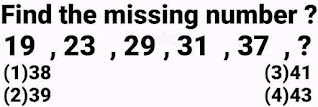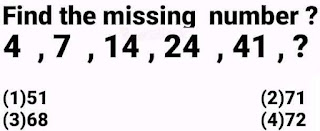Ten most important problems of missing numbers in Reasoning Analogy part 2
Series of missing numbers and missing terms and their solutions in reasoning analogy . These questions are very very important for upcoming competitive exams like SSC CGL ,SSC CHSL and RRB NTPC Etc.
Ten most important problems of missing numbers in Reasoning Analogy
This series consists of two alternate series. 1st series consist of number 1, 3, 5 and 7 and second series consist of the series 2 , 5 , 8 , ?
So in 1st series there is difference of 2, so next number in the series must be 2 greater than 7 i.e. 9
In the 2nd series we observed a difference of 3 show the next number must be 11 that is 3 greater than 8 the last term therefore the last two terms of the series 11 and 9.
The correct option is (1) 11,9
Problem # 2
This series is also the combination of two series one with the number 2, 48 ,16 ,32 and second series consist of these numbers 6, 9 13 ,18 , ? . So ? Will be filled out using 2nd series not from 1st series.
Observing 2nd series carefully ,In second series numbers are increased by 3 ,4 and 5 ,so next Increment should be of 6. This implies next number should be 24 with an increment of 6.
The correct option is (1)24
Problem # 3
Observe carefully all the numbers in the series are prime number , so next prime number after 37 will be 41 .This implies that ? will be replaced by 41.
The correct option is (3)41
Problem # 4
All the numbers in this series are consisting of three digits numbers and Middle digit is the sum of first and last digit in all the numbers except one that is 342 in this case 3 + 2 is equal to 5 not equal to 4 .So correct option is option is (c) ,this is the wrong number in the series .
The correct option is (3)342
Problem # 5
Every number in this series is the sum of its two preceding number plus 3.
14 = ( 7 + 4 ) + 3
24 = ( 14 + 7 ) + 3
41 = ( 24 +14 ) + 3
? = ( 41 + 24 ) + 3 = 65+3 = 68
The correct option is (3)68
Problem # 6
This series consists of triplet ,that is every third number is product its two preceding numbers
As third number 10 is the product of 2 and 5, sixth number 18 is the product of fourth (3) and fifth (6 ) numbers .
So ninth number of the series must be the product of seventh and eighth numbers. 4 × 7 = 28 instead of 30
The correct option is (3) 30
Problem # 7
Here second number is the sum of the digits of first number the forth number is the sum of digits of third number similarly every even positioned number is the sum of its preceding number's digits question mark will be replaced by the sum of 5 + 3 that is 8
The correct option is (1)8
Problem # 8
Writing 3 = 2² - 1
Writing 8 = 3² - 1
Writing 15 = 4² - 1
Writing 24 = 5² - 1
Show next number should be 6² - 1 (6 square minus 1 ) that is 35
Writing 6² - 1 = 35
The correct option is (2)35
Problem # 9
Every number in this series is the double of its preceding number .So double of 1 is 2 , double of 2 is 4 ,double of 4 should be 8 ( instead of 7 ) , double of 8 is 16 and double of 16 should be 32 . So 7 is the wrong number in this series.
The correct option is (1)7
Problem # 10
In the series every number is the the cube of its position plus 1 .
Since
2 = 1³ + 1
9 = 2³ + 1
28 = 3³ + 1
65 = 4³ + 1
126 = 5³ + 1
In the same way next number of the series must be 6³ + 1 = 216 + 1 = 217
The correct option is (1) 217
How-to-Solve-hard-and-impossible-Puzzles
TO CRACK ANY COMPETITIVE EXAM VISIT THIS YOUTUBE CHANNEL FOR MATHS AND REASONING
TO CRACK ANY COMPETITIVE EXAM VISIT THIS YOUTUBE CHANNEL FOR MATHS AND REASONING
EXAM CRACKER
My previous Post
FINAL WORDS
FINAL WORDS
Thanks for watching and responding to this post of reasoning based on mathematics and number sequence puzzle solver.
Appeal
If you are a mathematician Don't forget to visit my Mathematics You tube channel ,Mathematics Website and Mathematics Facebook Page , whose links are given below
Also watch this video









































